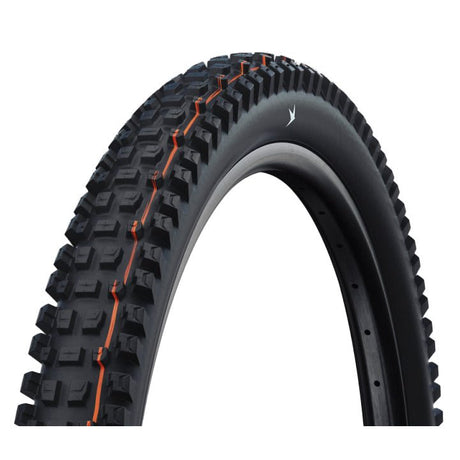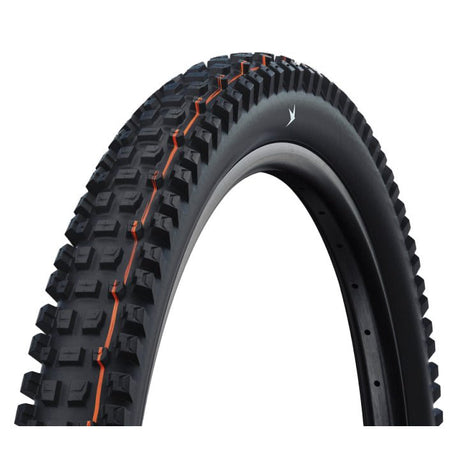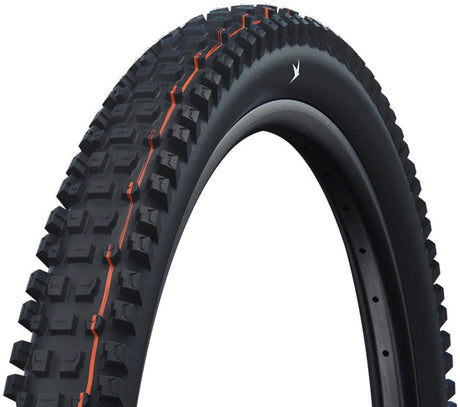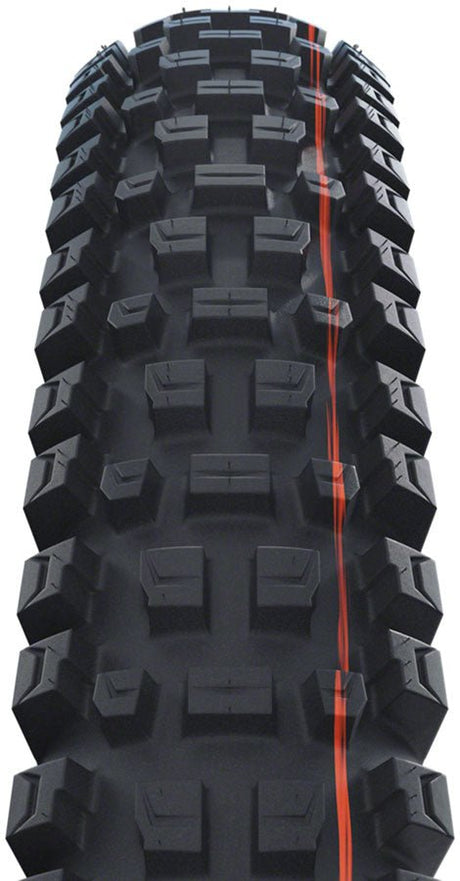Intro
The interaction between your bike and the trail is limited to just a few square inches of your tires touching the dirt. Even with all the fancy suspension tech and hyper engineered electronic shifting you install on your bike, your grip comes down to that tiny bit of surface area your rubber is sharing with the earth. Tire companies do everything they can to maximize the grip you get from that patch, and Schwalbe’s all new Albert has a redesigned tread pattern and casing to get as much grip as possible. I’ve had the Alberts on my bike for the last month through the variable conditions of Bellingham’s shoulder season, and have come away very impressed.
Let’s get the details out of the way so we can talk about the fun stuff. Albert has a tightly packed, repeating 3-2 knob pattern, with siping through each knob. Just like the Magic Mary, Albert’s side knobs come in pairs, and each of them have a medium amount of support down the sidewall. Albert doesn’t have the most aggressive knobs on the market, and if you’re looking for the tallest knobs out there, Albert isn’t it. Schwalbe is offering Albert in 27.5” and 29” options and 2.5” or 2.6” widths, but those measure in about .1 narrower than advertised. I’ve heard that may change in the future, but for now that’s the reality. Rubber options are Soft and Ultra Soft, and the star of the show is the sidewall construction. Schwalbe’s new radial sidewall construction debuted with this new tread as well as a few others, and comes in Trail Pro and Gravity Pro. I’ve broken down all the details of Schwalbe’s new radial casing in another blog, so I’ll spare you all the details here.
Albert’s price is incredibly similar to other Schwalbe tires and their competitors, hovering around the hundred dollar mark depending on the exact spec. Weight is also about what you’d expect, with my 29x2.5” Trail Pro Albert weighing 1141 grams and my 29x2.5” Gravity Pro Albert weighing 1310 grams. Looking across the aisle, these weights are very comparable to Maxxis’ EXO+ and DoubleDown weights respectively. We haven’t gotten any official word on this, but it seems like Schwalbe could be replacing their Super Trail and Super Gravity tires with these new radial casings, so we’ll see if Super Race, Super Ground, and Super Downhill get the same treatment down the line.
Schwalbe Albert
- Radial construction
- Soft and Ultra Soft rubber compounds
- Gravity Pro and Trail Pro casings
- 29" or 27.5" diameter
- 2.5" or 2.6" width
- Repeating 3-2 center knob pattern
- 1310g: 29"x2.5" Gravity Pro
- 1141g: 29"x2.5" Trail Pro
- $98-104
Setup
My personal setup is the Ultra Soft 29x2.5” Albert in front and rear, with the lighter Trail Pro casing up front and heavier duty Gravity Pro casing in the rear. Getting these tires mounted on my Reserve HD|30 carbon rims was as pain free as you’d expect with brand new wheels and tires. Inside, I’ve got standard Stans sealant as the glue holding everything together. There’s a 169 gram weight penalty for the Gravity Pro casing compared to Trail Pro, and both have their place on anything from a trail bike to a downhill bike. There currently isn’t a cross country oriented radial casing option, and for now it’s reserved for bikes where downhill performance is a priority.
Looking down at Albert is a confidence inspiring sight, with a smattering of knobs all over the tire. There’s no noticeably large gaps between the knobs, and it’s impossible not to draw the comparison between the Albert and the Assegai and the Magic Mary. Each of these tires have the same 3-2 pattern of center knobs, but they’re each executed differently. Schwalbe’s Magic Mary has far more space between each knob than the other two, while the Assegai has similar spacing to the Albert but with taller knobs. Albert’s profile is slightly more squared off than an Assegai, but it’s not so square that it feels like you’re cornering on a knife’s edge.
Riding Albert
My first ride on the Albert tires was during the latest Atmospheric River, where we received about two inches of rain during that weekend, and I quickly learned that Albert is not a wet weather specialist. One look at the relatively short knobs could have clued you into that, but let me be clear in that Albert is not prepared to penetrate loose soil like a Dirty Dan or Shredda. It packed quickly and did a poor job of shedding mud in those sloppy conditions, but that’s not what the tire was designed for. Since then, things have dried up, and we’ve had a great mix of hero dirt and sloppy rides you can expect this time of year.
Albert’s tread is happiest on hard pack trails, where the terrain is relatively predictable and it can consistently get several of its knobs onto the ground at once. Cornering becomes a joy, with an indiscernible transition between center and side knobs, much like the Maxxis Assegai. Holding consistent grip while leaning over in a corner is among my top priorities in a front tire, and the Albert’s contact patch manages to hold true all the way from its vertical to its most horizontal position. It’s incredibly reminiscent of the Assegai in this sense, a fan favorite of ours and many of our customers.
What’s been most compelling about the Albert tire isn’t actually the tread, but rather the casing that delivers the tread. Shwalbe’s radial casing is designed to give more grip than a traditional bias ply tire, and while radial tires are the standard in automotive rubber, the technology has never made its way over to mountain bikes. The idea with the radial construction is that your tires are more compliant, conforming more easily to the terrain and ultimately giving you more grip. That compliance means the radial tires are inherently less supportive in corners, and after starting at my typical pressures of 23 and 27 psi, I’ve slowly crept up to 27 and 32 psi after a series of burps and dings my Reserves didn’t appreciate. With those higher pressures, the tires feel both similar and completely dissimilar to more typical construction tires.
For the classic Bellingham trails with soft dirt and slippy roots, I typically wouldn’t dream about running 27 psi in the front, but the radial tires need a higher pressure to retain their shape when push comes to shove. Hitting rocks and roots with the aired up radials still feels like you’re hitting obstacles with a firm tire, but without the negative side effects of getting pinged off line or losing traction. First impact is definitely a bit harsh, but the tire sticks so well to whatever you hit. When landing on a web of roots or rocks where I would expect my tire to slip and ping as it touches down, the Albert was able to stick more effectively than any tire I’ve ridden before. Whether that was thanks to the radial construction or new Albert tread pattern is hard to say, but suffice to say it’s a winning combination. It took a couple weeks on the Alberts for my brain to recalibrate its internal grip to air pressure ratio that it’s developed over the last 12 years of riding bikes. My brain would always tell me that the tire feels too firm to maintain traction, but the tires would just keep holding their line, rarely understeering or pushing out from under me.
Just like the previous generation of Schwalbe tires, the Ultra Soft compound performs very similarly to the Maxxis MaxxGrip compound, another fan favorite. I don’t believe the rubber compound has been changed at all, and for good reason. It continues to be at the sharp end of tire technology, offering amazing traction that all gravity riders are going to appreciate. For riders looking for more climbing efficiency, I would definitely recommend a Soft compound rear tire paired with the Ultra Soft, plus you’ll get more life out of the slightly harder Soft compound.
Braking performance with the Alberts was much better than I expected. On paper, this tread looks to be a front tire specialist, optimized around cornering grip rather than braking grip, but the radial casing allows the Albert to have its cake and eat it too. Heavy braking was where I felt the radial casing most dramatically, and the willingness of the casing to conform to the terrain makes a noticeable difference in performance. I can almost picture the tire hugging each rock it passes by as I engage the brakes, and I can’t wait to try something like a Big Betty with a radial casing in the rear to really stop on a dime.
Conclusion
Albert is certainly going to be a front tire specialist, with amazing knob coverage that makes the Albert one of the most consistent tires I’ve leaned over in a flat corner. For everyone riding the dry hardpack trails in Southern California and Colorado, I don’t think there’s a better front tire on the market. Winter time slop rides will definitely call for a different tire, but for half the year here in Washington, this will be my new go-to tire. I can’t wait for Schwalbe to expand their range of Radial tires, and while the tire feels quite different to anything else I’ve ridden before, the grip and overall performance is undeniable. Comfort is slightly sacrificed at the higher pressures a radial tire demands, but if you want to make the most of your little contact patch on the trail, you won’t find more grip elsewhere. I can only expect other tire companies to release their own radial versions down the line.







